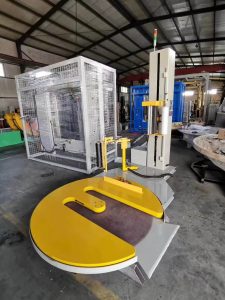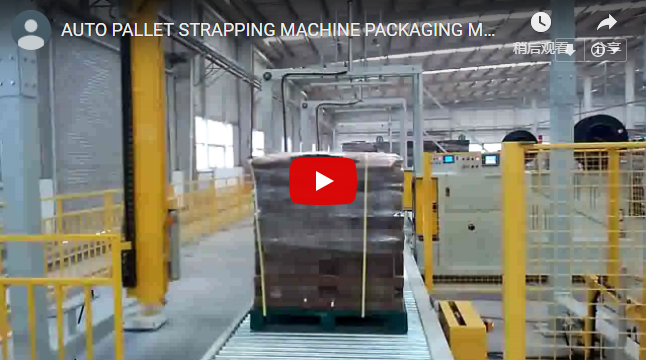Technical Guide to Automatic Pallet Strapping Machines: Operation, Benefits, and Integration
1. Introduction to Automated Pallet Strapping
Automatic pallet strapping machines are essential components in modern logistics and manufacturing environments, designed to secure palletized loads efficiently and reliably. They automate the process of applying, tensioning, sealing, and cutting straps (typically Polypropylene - PP or Polyester - PET) around a pallet, ensuring load stability during transit and handling. Understanding the technical aspects and operational benefits of these machines is crucial for optimizing end-of-line packaging processes. This guide provides a technical overview, operational insights, and considerations for integrating these systems.

2. Operational Process Explained
The core function of an automatic pallet strapper involves several sequential steps:
- Pallet Positioning: The pallet load is typically moved into the strapping station via conveyor systems. Sensors detect the pallet's presence and correct positioning.
- Strap Arch Feeding: A strap arch surrounds the pallet path. The machine feeds the appropriate length of strapping material through the arch and around the pallet load.
- Strap Tensioning: Once the strap encircles the load, a tensioning mechanism pulls the strap tight to a pre-set level. Consistent tension is critical for load security. Tension levels can usually be adjusted based on the product's nature (e.g., rigid boxes vs. compressible goods).
- Strap Sealing: The overlapped ends of the strap are securely joined. Common methods include:
- Heat Sealing: Melts the strap ends together using a heated blade.
- Friction Weld Sealing: Generates heat through high-speed friction between the strap ends, creating a strong bond.
- Strap Cutting: After sealing, the strap is cut cleanly from the supply coil.
- Arch Retraction/Pallet Exit: The arch may lift or retract, and the strapped pallet is conveyed out of the station, ready for the next process (e.g., wrapping, storage, or shipping).
The video above demonstrates a typical automatic pallet strapping machine in operation, showcasing the sequence and efficiency.
3. Key Technical Specifications and Machine Parameters
When evaluating or operating automatic pallet strappers, consider these technical parameters:
- Strapping Speed: Measured in cycles per minute or seconds per strap. Typical speeds range from 10 to 60+ straps per minute, depending on the machine model and arch size.
- Arch Size (W x H): Must accommodate the largest pallet load dimensions planned. Standard and custom sizes are available.
- Strap Type Compatibility: Machines are usually designed for specific strap types (PP or PET) and dimensions.
- Strap Width: Common sizes include 9mm, 12mm, 15.5mm.
- Strap Thickness: Varies depending on required strength.
- Tension Range: The minimum and maximum force the machine can apply (e.g., 100 N to 2500 N or more). Adjustable tension is a key feature.
- Sealing Method: Heat seal or friction weld, each having implications for maintenance and joint strength.
- Control System: Typically PLC-based (Programmable Logic Controller) for operational logic, diagnostics, and integration capabilities. HMI (Human-Machine Interface) panels allow for parameter adjustments and monitoring.
- Power Requirements: Voltage, phase, and power consumption specifics.
- Optional Features: Top press for unstable loads, automatic strap loading, multiple strap patterns, conveyor integration modules.
4. Operational Benefits and Experience Sharing
Implementing automatic pallet strapping offers tangible advantages:
- Increased Throughput: Significantly faster than manual or semi-automatic methods, reducing bottlenecks in the packaging line. Throughput gains can often exceed 300% compared to manual strapping.
- Improved Load Stability & Safety: Consistent strap placement and tensioning secure loads effectively, reducing product damage during shipping and handling, contributing to safer warehouse operations.
- Reduced Labor Costs: Automating the strapping process frees up personnel for other value-added tasks. Payback periods based on labor savings can be relatively short.
- Material Cost Optimization: Precise strap feeding and tensioning minimize strap waste compared to manual application.
- Consistency: Ensures every pallet is strapped according to the same specifications, crucial for quality control and customer satisfaction.
From Experience: Proper operator training is vital for maximizing uptime. Regular cleaning of the strap path and inspection of the sealing head/welding mechanism are key preventative maintenance tasks. Using the correct grade and quality of strap specified by the machine manufacturer prevents jams and ensures reliable sealing.
5. Integration within Packaging Lines
Automatic pallet strappers rarely work in isolation. They are often integrated into comprehensive end-of-line packaging systems:
- Conveyor Systems: Infeed and outfeed conveyors are necessary for automated pallet movement.
- Pallet Stretch Wrappers: Often positioned immediately after the strapper. The sequence (strap then wrap, or sometimes wrap then strap) depends on the product and stability requirements. Integration ensures seamless transfer between machines.
- Palletizers: Robots or conventional palletizers feed completed loads to the strapping station.
- Line Control: Integration typically involves communication protocols (e.g., Ethernet/IP, Profinet) between the strapper's PLC and the main line controller for synchronized operation.
FHOPE offers integrated solutions, potentially combining strapping and wrapping functions in a single line, streamlining the footprint and workflow.
6. Selecting the Appropriate System
Choosing the right automatic pallet strapper involves assessing:
- Throughput Needs: Match machine speed to your line's output requirements.
- Load Characteristics: Consider pallet size, weight, stability, and product type (e.g., requires top compression?).
- Strap Requirements: Determine the necessary strap type (PP/PET) and strength based on load weight and shipping conditions.
- Integration Complexity: Assess compatibility with existing or planned conveyors and other packaging equipment.
- Budget and ROI: Balance initial investment against long-term savings in labor, materials, and reduced damage.
- Service and Support: Consider manufacturer support, parts availability, and maintenance accessibility.
7. Conclusion
Automatic pallet strapping machines provide a robust solution for enhancing packaging efficiency, improving load security, and reducing operational costs. By understanding their mechanics, operational parameters, and integration possibilities, businesses can leverage this Mtechnology to optimize their logistics and material handling processes. Careful selection based on specific application needs ensures maximum return on investment and operational reliability.
https://www.fhopepack.com/Stretch_wrapping_machine.html
info@fhopepack.com


